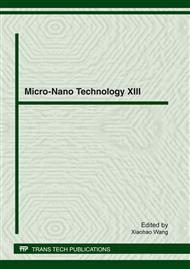p.128
p.134
p.139
p.145
p.151
p.156
p.163
p.169
p.174
A Silicon Micro-Accelerometer with Triangle Cross-Section Beam by Anisotropic Wet Etching in TMAH Solution
Abstract:
A capacitive accelerometer with triangle cross-section beam fabricated by anisotropic wet etching of (100) silicon is presented in this paper. The feature of this accelerometer is that eight suspension beams with triangle cross-section are formed by anisotropic wet etching of (100) silicon in TMAH solution, without heavy boron doping or Si-Si bonding. When the width of beam is decided, the beam’s geometry is determinate. The formation procedure of the triangle cross-section beam is analyzed in detail. Through this beam-fabrication approach, the beam’s thickness can be well controlled by beam’s width and intrinsic stress in the beams is minimized. Accelerometers with different sensitivities can be easily fabricated by varying the width of the beams. For a device with 23 μm width beams, the resonance frequency and the quality factor are 644 Hz and 32, respectively. The sensitivity of accelerometer is measured as 2 V•g-1.
Info:
Periodical:
Pages:
151-155
Citation:
Online since:
February 2012
Authors:
Keywords:
Price:
Сopyright:
© 2012 Trans Tech Publications Ltd. All Rights Reserved
Share:
Citation:


